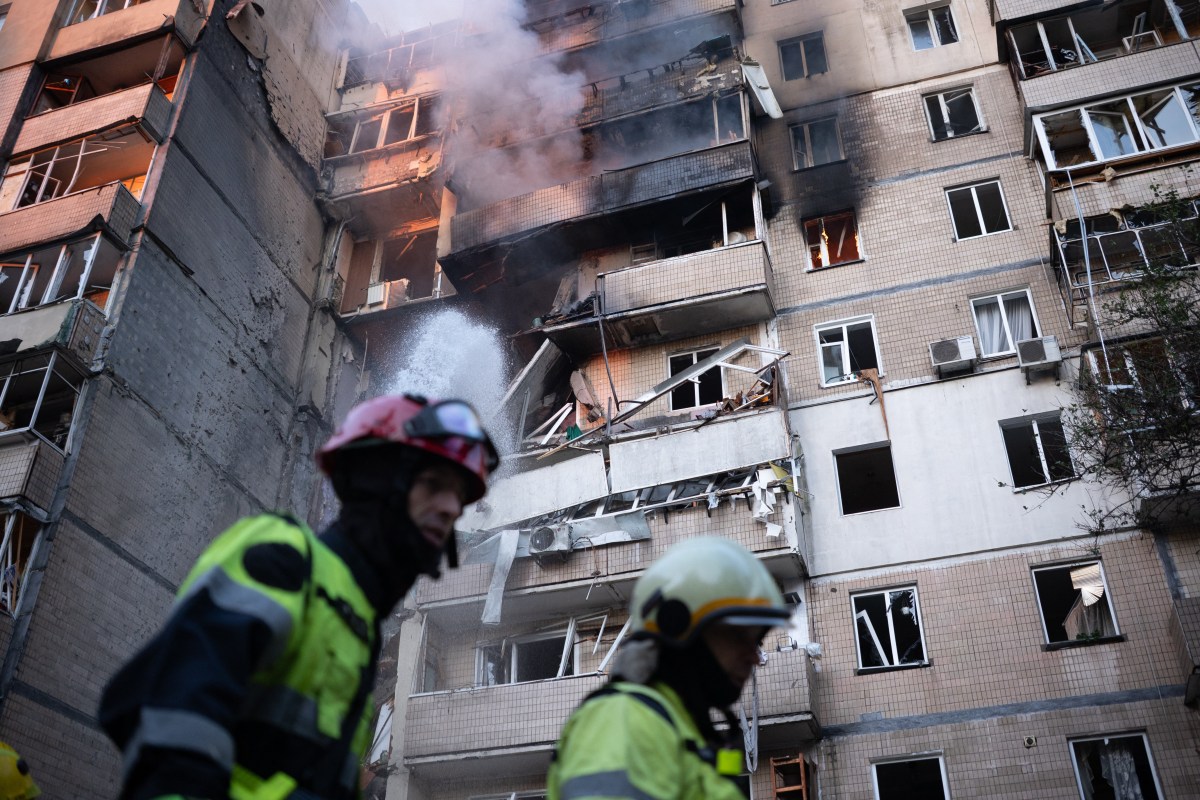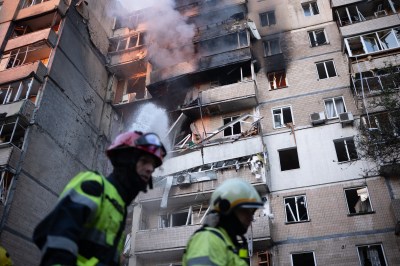Turn any article into a podcast. Upgrade now to start listening.
Premium Members can share articles with friends & family to bypass the paywall.
Happy Wednesday! The New York Post reported yesterday that retired Marine Corps officer Oliver North and Fawn Hall—North’s secretary at the National Security Council who helped him destroy documents—secretly got married last month, 40 years after the Iran-Contra scandal that brought them to headlines. It’s never too late for love, it seems.
Quick Hits: Today’s Top Stories
- Israel struck leaders of Hamas meeting in Qatar on Tuesday, expanding the war against Hamas to a new country and angering Middle Eastern governments. The attack was conducted by the Israeli Air Force, targeting a building in Doha, and senior members of Hamas’ negotiating team, who Hamas claimed were meeting to consider a U.S. peace proposal. According to Israeli media, Israeli officials are skeptical that the strike was successful, and Hamas has claimed that senior members of the negotiating team survived, while the son of Khalil al-Hayya, Hamas’ chief negotiator, was killed. Qatar said a member of its internal security force was also killed in the attack, which it condemned as a “blatant violation of all international laws and norms.” According to the Wall Street Journal, Israel informed the White House of the incoming strike, but only minutes beforehand, without providing the exact target or location. White House press secretary Karoline Leavitt said that the attacks on Qatar—a “close ally”—did not “advance the U.S. or Israel’s goals,” and President Donald Trump denied having any involvement.
- The Bureau of Labor Statistics on Tuesday released preliminary benchmark revisions of job market data for the last year through March, which showed that the total number of workers on payrolls is likely to be revised down by 911,000. Government data from before the revision indicated that the U.S. economy created roughly 1.8 million jobs in the 12 months preceding March, around twice what it now believes to be the actual number. The report adds weight to the claim that the U.S. is experiencing a weak jobs market and makes it more likely that the Fed will cut interest rates during its September meeting. To learn more about the U.S. jobs market, read yesterday’s TMD.
- Polish Prime Minister Donald Tusk announced Wednesday that Poland’s military shot down Russian drones that violated its airspace during an overnight attack on Ukraine, marking the first time a NATO member has engaged Russian assets since the invasion began. The Polish military’s operational command called the incursion an “act of aggression” that posed a threat to citizens’ safety, with Tusk confirming a “huge number” of drones crossed into Polish territory as Russia launched strikes involving 415 drones and 40 missiles against western Ukraine. Officials activated defensive procedures immediately and worked with NATO allies, including Dutch F-35 fighter jets, to neutralize the threats, temporarily closing Warsaw’s airport and portions of surrounding airspace. EU foreign policy chief Kaja Kallas said the violation appeared intentional rather than accidental.
- U.S. District Judge Jia Cobb ruled Tuesday that Federal Reserve Governor Lisa Cook can remain in her position while she fights Trump’s attempt to fire her for alleged mortgage fraud. The court granted a temporary restraining order blocking Cook’s removal after finding that Trump had not stated a legally permissible cause, noting that Fed governors cannot be fired over policy disagreements and that the president’s allegations appeared pretextual. Cook, the first black woman to serve on the Fed board, will continue participating in upcoming meetings, including the September 16-17 session in which a quarter-point rate cut is expected. Cook’s attorney, Abbe Lowell, said the ruling reaffirms the importance of safeguarding Federal Reserve independence from illegal political interference, while the White House maintains Trump lawfully removed Cook for cause.
- The Supreme Court announced Tuesday it will decide whether Trump exceeded his authority by imposing sweeping tariffs under emergency powers, scheduling oral arguments for the first week of November. The case follows an appeals court ruling that Trump overstepped his presidential powers when using the International Emergency Economic Powers Act to impose tariffs without congressional approval, finding that the Constitution assigns tariff authority exclusively to Congress. Treasury Secretary Scott Bessent warned that if the court rules against the administration, it could trigger massive refunds of $750 billion to $1 trillion already collected, potentially causing significant economic disruption. The tariffs remain in effect while the court considers the case, with the administration arguing that blocking them would derail critical negotiations with foreign trading partners and threaten broader U.S. strategic interests. To learn more about the legal case against the tariffs, read the September 4 edition of TMD.
- The U.S. Education Department on Tuesday announced that test scores showed 12th-graders’ scores on math and reading test scores fell to record lows. The National Assessment of Educational Progress, taken by tens of thousands of students last year, showed the continuation of declines in academic skills that began before the COVID-19 pandemic. Of high school seniors who took the math test, administered since 2005, only 22 percent were classified as proficient, and only 35 percent of those who took the English test, which dates back to 1992, achieved the same score. Experts attribute the deepening slide to increased screen time, pandemic-era disruption, and high rates of absenteeism.
- Michigan District Court Judge Kristen Simmons dismissed criminal charges against her state’s “fake electors:” 15 Republicans who signed statements claiming that Trump won the state of Michigan and its electoral votes during the 2020 election. Michigan Attorney General Dana Nessel brought fraud charges against 16 people (but later dropped the charges against one individual) two years ago, claiming that they sought to falsely and knowingly overturn the results of the election. Simmons said that there was insufficient evidence to prove intent, making further prosecution for fraud untenable.
- French President Emmanuel Macron named Defense Minister Sébastien Lecornu as his next prime minister on Tuesday, succeeding François Bayrou, who lost a confidence vote on Monday over proposed austerity measures. Lecornu, a longtime Macron ally and a member of his Renaissance party, will be the fifth prime minister of Macron’s second term, which began in 2022. The move comes as a wave of “Block Everything” protests, signaling opposition to Macron and his proposed spending cuts, kicks off across the country.
- Health and Human Services Secretary Robert F. Kennedy Jr. unveiled his “Make Our Children Healthy Again Strategy” report on Tuesday, outlining 128 proposals to combat childhood chronic disease through nutrition, exercise, and vaccine policy reforms. The report calls for a new vaccine framework to review the childhood immunization schedule and investigate vaccine injuries while emphasizing “transparent, gold-standard science”—but favors voluntary industry compliance and new studies over regulatory action. Public health experts expressed concern that the report’s vaccine skepticism could undermine childhood immunization efforts, with the American Lung Association warning that questioning the vaccine schedule “puts children’s lives at risk.”
A message from Political Wire
Concise. Relevant. To the Point.
Political Wire is where serious political junkies stay ahead. Join thousands of insiders who rely on Taegan Goddard’s exclusive analysis, a 24/7 trending news feed, bonus newsletters and a completely ad-free experience. The site is free to visit and the community is free to join—but membership gives you the edge. Use coupon code “dispatch” for 20% off an annual plan. Get Insider Access.
Remote Control Warfare

Ukrainians can’t sleep. In cities across the country, nighttime comes with the arrival of Russia’s killer drones, targeted explicitly as civilian infrastructure. Since August 19, there have been at least five separate instances in which Russia deployed hundreds of military drones in aerial attacks that resulted in Ukrainian civilian casualties. Survivors go through their day knowing the next round may come that night. For some areas of Ukraine, drone showers are more frequent than rain.
Meanwhile, Ukraine has developed a local drone industry, building light, cheap drones to target Russian military bases, weapons depots, and energy infrastructure. In early June, semi-trucks carrying modular homes entered Russian territory, which concealed containers full of short-range Ukrainian drones. Russia’s Defense Ministry said those drones attacked airfields in at least five regions in the country—including Irkutsk, roughly 2,670 miles from the front line—while a New York Times analysis of videos and satellite imagery showed that Russian strategic bombers were destroyed in at least two of those airfields.
As a non-paying reader, you are receiving a truncated version of The Morning Dispatch. You can read our full item in the members-only version of TMD.
Automated aerial weapons are not a novelty, but Russia’s invasion of Ukraine is the first war in which both sides have used swarms of small drones on the battlefield. And with American and central European defense start-ups working to bring Western militaries up to speed with drones, expect this only to be the first such conflict.
It’s not surprising that both sides have so aggressively embraced drones. Not only do they open strategic avenues that are impossible or impractical with more traditional arsenals, but they can be cheaper and faster to make than artillery shells or missiles. And, during war, the factory-to-battlefield pipeline is key.
“Traditional industrial bases were unable to build the number of artillery shells and missiles needed for the protracted conflict, forcing both sides to turn to new capabilities,” Bryan Clark, a senior fellow at the Hudson Institute and director of the group’s Center for Defense Concepts and Technology, told TMD.
While the European Union provided approximately 500,000 artillery shells to Ukraine in 2023, Ukrainian President Volodymyr Zelensky said that his country’s factories produced around 2.2 million drones the following year. In 2025, Ukraine aims to increase total drone production to 4.5 million. “The Ukrainians have demonstrated a tremendous energy in this area in terms of producing low-cost drones in very large numbers, which helps, in some respects, to make up for manpower shortages,” John Arquilla, a longtime defense analyst who previously had a small role in advising a Ukrainian military operation in the Black Sea, told TMD.
Russia has also ramped up production, focusing particularly on churning out long-range, one-way attack drones, such as the Iranian-designed Shaheds, which the Kremlin has previously purchased from Tehran but now manufactures on Russian soil, integrated with its own guidance technology. While total production figures are not publicly available, the country’s Alabuga Special Economic Zone has multiplied its production of Shahed drones by a factor of nine, according to the Russian company’s CEO, Timur Shagivaliev.
“There’s definitely economies of scale,” Jacquelyn Schneider, director of the Hoover Institution’s Wargaming and Crisis Simulation Initiative, told TMD. At the same time, cutting corners in production can come at a cost. “You can’t make something that is all-quantity and all-quality,” she added. “There is an inherent trade-off.”
According to a report from the Russian-based, Kremlin-banned media outlet, The Insider, school-age children in Russia are assisting in the effort. What reportedly begins as video game and coding competitions, according to one 16-year-old involved, leads to students becoming “actively involved in modeling system nodes for various drones.”
Beyond building them cheaply and at scale, the “real innovation,” as Schneider explained, is how both sides have applied drone technology to address numerous war challenges, including “intelligence, the logistics, and even the ability … to bring blood and supplies to the front line.” Alongside offensive drones, the Ukrainian military uses land drones—unmanned ground vehicles that resemble something between a tank and the Mars rover—as ambulances to quickly transport injured soldiers.
Militarized drones also come in a range of types, each suited for specific purposes. While Shaheds can traverse hundreds of miles—with some newer models capable of traveling more than 1,500 miles—other types are used in short-range combat. “I would probably categorize them as completely different military weapons,” Schneider said, outlining the four most significant differences as “the range, the control, the purpose, and then usually the cost.”
Long-range drones are “a little bit more like cruise missiles,” she added. Both are used to target critical infrastructure deeper within enemy territory, such as power plants or supply warehouses—though Russia has also notoriously fired Shaheds and missiles into Ukrainian cities, often targeting civilian homes. Samuel Bendett—an adviser to the Center for a New American Security and subject matter expert in Russian military autonomy and AI for the Defense Department’s Defense Systems Information Analysis Center—told TMD that Russia’s intent with these long-range strikes targeting cities is “to demonstrate that Ukraine does not have control of its airspace, and to demonstrate that Ukrainians could be hit at any point in given time.” He added, “These long-range attacks have always had the purpose of trying to break the population and its will to fight.”
Such long-range attacks are, Arquilla explained, “an attempt to use a very old paradigm, the strategic bombing paradigm, to say that somehow we’re going to break the will of our opponents by bombing these distant targets.” But he believes reliance on strategic bombing has always been “overrated and continues to be” in this case. “The idea that drones somehow give new energy to strategic bombing is a mistake,” Arquilla said. “The potential of drones, if it is to be optimized or actualized, will only be at the tactical level,” not long-range air strikes.
The contributions of short-range drones aren’t limited to providing additional firepower or defense. As with soldiers, drones are often specialized in specific roles and objectives. Some are designed solely for surveillance and reconnaissance work, while others support infantry and airborne units in battle. Others plant—or detect—land mines, and they’re also used in electronic warfare, jamming the communication of enemy drones (and, in some accidental circumstances, their own).
In many cases, such as first-person view drones, a human pilot steers the drone remotely, with one Ukrainian operator telling The Guardian that he is “killing at least three Russian soldiers” per day. But this digital connection can be easily jammed by identifying the drone’s radio frequency. “With the advent of widespread GPS jamming, the first generation of drones fielded in the war are now obsolete,” Clark noted. “Both sides had to invest in drones that use other sources of navigation like terrain mapping with cameras, using known TV or radio transmitters as reference points, or homing on GPS jamming signals themselves.”
Both sides have also invested in AI-powered navigation systems, allowing drones to automatically steer and identify potential targets—but AI technology has also made it easier to jam enemy drones. “We thought AI could change the fog of war,” Schneider said. “That seems to be, actually, one of the consistencies of warfare across time … The use of AI and other digital technologies to try to both encrypt and decrypt wireless transmissions, that’s been kind of remarkable watching the pace of innovation there.”
Another solution to the communication disruption problem—which Russia was the first to develop and deploy successfully—is to create drones that communicate via miles-long fiber optic cables instead of radio frequencies. While attaching a cord of up to 12 miles in length to a flying robot may not seem to be sophisticated military technology, it’s preferable to losing all communication signals to the drone, and jamming signals have proven easier than cutting a cord in mid-air. “That’s going to be a central issue in the future of drone warfare,” Arquilla observed. “Every time there’s some innovation in warfare, there’s always a counter-reaction to it.” In late May, Ukraine Minister of Digital Transportation Mykhailo Fedorov tweeted that 15 Ukrainian manufacturers “are already developing” fiber optic drones for military operations, with an additional 20 “working on components.”
In this sense, competitive advantages are achieved not just by having the most advanced technology, but also by swiftly and seamlessly adapting to the opposition’s own wartime tech. That “tit-for-tat in drone, counter-drone, [development] has been really, really remarkable in this conflict,” Schneider said.
Therefore, less important is “who can develop the drones that are the fastest or [has] the best precision,” she added. “It’s who can get them on the battlefield as quickly as possible.
Today’s Must-Read
Last week, the Department of Defense renamed itself the Department of War. Never mind that the department’s name is prescribed by Congress and can’t actually be changed by presidential fiat. The Trump administration and its allies made a big show of renaming the department anyway, with a social media blitz emphasizing WAR in capital letters and a speech from Secretary of Defense Pete Hegseth in which he recited slam poetry about how he wanted “maximum lethality, not tepid legality. Violent effect, not politically correct.” The administration clarified that the department’s legal name was still Defense (they’re seeking congressional approval for the name change). Until then, War is being used as a “secondary title,” making this pointless exercise the MAGA equivalent of changing your pronouns. It’s the latest absurdity to come out of the Trump administration, and hardly the most consequential. But it is part of a troubling trend.
Toeing the Company Line
The Final Boss
Jeffrey Epstein and America’s broken windows.
For Iranians, War With Israel Still Looms Large
‘Every day, we wait for a foreign country to attack our homeland to help us live.’
From No-No to ‘Oh, No’
Baseball magic in Baltimore.
The DOJ Pandered to Hysteria. The NRA Pushed Back.
Some in the Trump coalition still have the capacity to think beyond the horizon of a news cycle.
Gay Race Communism | Interview: Chris Stirewalt
‘Sounds more fun than regular communism.’
Worth Your Time
For Democrats to have a chance at winning federal office in Texas, they need as close to a perfect candidate as they can find. Some are hoping they’ve found that in the young, eloquent, and religious James Talarico, who announced yesterday that he would be running in the Democratic primary for the Senate seat held by John Cornyn. Elaine Godfrey writes about his run for The Atlantic: “You might recognize the 36-year-old state lawmaker from any number of viral social-media clips—calmly arguing with Fox News hosts, for example, or discussing his faith on Joe Rogan’s podcast in May. The four-term Democrat and Presbyterian seminarian this morning announced that he’s joining the primary race for the Senate seat held by the Republican John Cornyn. In so doing, Talarico has cemented himself as his party’s newest, shiniest 2026 contender. Talarico stands out for his relative youth but also for his particular brand of long-winded eloquence. He can sound, in some ways, like a southern-style Barack Obama or a Texas Pete Buttigieg. Two years ago, a video made the rounds of Talarico arguing against legislation that would require public-school teachers to hang the Ten Commandments in their classroom. ‘This bill to me is not only unconstitutional; it’s not only un-American; I think it is also deeply un-Christian,’ he told his Republican colleagues in a committee hearing. ‘And I say that because I believe this bill is idolatrous. I believe it is exclusionary. And I believe that it is arrogant—and those three things, in my reading of the Gospel, are diametrically opposed to the teachings of Jesus.’ Democrats hope his emphasis on faith will help Talarico reach across the aisle—something he seems eager to do. In an interview, Talarico told me that wooing voters is like navigating a school cafeteria. ‘You sit at the table where people want you to sit,’ he said, and ‘it’s our job as elected leaders’ to show voters that they’re wanted. This, Talarico says, is why he spent two hours talking with Rogan, who endorsed Donald Trump in 2024. ‘You need to run for president,’ Rogan told him by the end of the show. ‘We need someone who’s actually a good person.’”
Presented Without Comment
Associated Press: Alex Jones Asks US Supreme Court To Hear Appeal of $1.4 Billion Sandy Hook Judgment
Also Presented Without Comment
Mediaite: RFK Jr. Doubles Down On Video Games and Psychiatric Drugs as a Cause for Mass Shootings
Also Also Presented Without Comment
Politico: White House Issues Fresh Denials Upon Release of Epstein Birthday Greeting
The letter features an outline of a woman’s body and bears Trump’s signature at the bottom. It was among a collection of birthday greetings gathered for Epstein’s 50th birthday by Ghislaine Maxwell.
Top White House aides are pointing to discrepancies between the signature on the greeting and the president’s signature.
“Time for @newscorp to open that checkbook, it’s not his signature. DEFAMATION!,” White House deputy chief of staff Taylor Budowich wrote on X alongside images of Trump’s signature from his first presidential term and a copy of a signed book detailing his 2024 presidential campaign.
“As I have said all along, it’s very clear President Trump did not draw this picture, and he did not sign it,” White House press secretary Karoline Leavitt said in a statement on social media. “President Trump’s legal team will continue to aggressively pursue litigation.”
Let Us Know
Have any thoughts or questions about today’s newsletter? Drop us a note in the comments!
















Please note that we at The Dispatch hold ourselves, our work, and our commenters to a higher standard than other places on the internet. We welcome comments that foster genuine debate or discussion—including comments critical of us or our work—but responses that include ad hominem attacks on fellow Dispatch members or are intended to stoke fear and anger may be moderated.
With your membership, you only have the ability to comment on The Morning Dispatch articles. Consider upgrading to join the conversation everywhere.